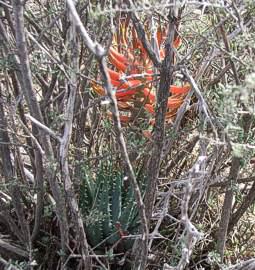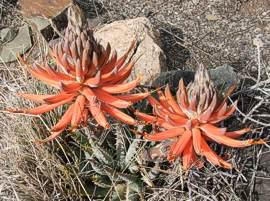Aloe longistyla
Aloe longistyla Baker
Family: Asphodelaceae
Common names: Karoo aloe (Eng.); ramenas, Karoo-aalwyn (Afr.)
Introduction
Aloe longistylsa is a small and elusive aloe that uses excellent camouflage to help it blend in with its environment. It is only easily seen in its natural habitat when in flower.

Description
Description
Aloe longistyla is a dwarf aloe, characterized by its exceptionally small rosettes. Plants are stem-less, usually solitary, but may well have 2 or 3 rosettes. The densely crowded, greyish-green leaves have a conspicuous waxy layer on their surfaces. The leaves are lanceolate, up to 150 mm long and 30 mm wide near the base. There are firm white spines of up to 4 mm long on both surfaces, and rows of these spines can also be seen along the leaf margins. Each of these spines has a white tuberculate base.
The inflorescences are dense, broad, cone-shaped racemes which appear singly or in pairs of up tot 200 mm high with very thick unbranched peduncles. Up to 50 pale salmon-pink to coral-red flowers are borne on these plants in the winter from July to August. Relative to the small size of the plant, the flowers are exceptionally large, up to 55 x 10 mm. An unmistakable characteristic of the flowers is that their upper halves are curved upwards to expose the unusually long stamens and styles that protrude for more than 20 mm from the mouth of the flower tubes. Fully exerted styles have a length of up to 75 mm, making them the longest known styles for any South African aloe.
As with other members of the Asphodelaceae, the fruit is a typical capsule and seeds are winged, also quite large for such a small plant. Seeds ripen normally around October to November. This aloe, when not in flower, may easily be confused with A. humilis and A. brevifolia which superficially look similar but their flowers do not posses the unusually long styles found on A. longistyla. For the untrained eye, it would be easier to distinguish these species when they are in flower.
Conservation Status
Status
Aloe longistyla has a relatively large distribution range but, despite this, it is considered a vulnerable species. Major threats include illegal collecting, habitat degradation and particularly overgrazing due to livestock farming in its natural range.
Distribution and habitat
Distribution description
Aloe longistyla is found over large areas in the summer-rainfall regions of the semi-arid Little Karoo and south-eastern parts of the Great Karoo from Calitzdorp in the west to near Grahamstown in the east, and extending northwards to Graaff-Reinet, Cradock and Middelburg.
Populations are found as scattered individuals, never in dense groups and often partly shaded by short, scrubby vegetation predominantly of Pentzia, Pteronia and Nestlera species.

The terrain is flat or gently sloping in stony or sandy areas, mostly associated with fragmented dolerites, mudstones and shales.
Derivation of name and historical aspects
History
The genus name Aloe is derived from the Arabic, alloch, and translated as allal in Greek and Hebrew, literally meaning bitter or bitter sap which is descriptive of aloe sap. The specific epithet longistyla is aptly chosen, as the characteristically long style is 70-75 mm long and is an unmistakable feature of the flower. Other species in this group (grouped as Dwarf Aloes in Guide to SA Aloes according Smith G and Van Wyk B E) include Aloe aristata, A. bowiea, A. brevifolia, A. humilis, and A. variegata.
The genus Aloe has recently undergone estensive revision and some of the names mentioned in this article may have changed (2015).
Ecology
Ecology
Aloe longistyla produces nectar and is pollinated by sugar birds as well as winged and crawling insects such as ants which are small enough to enter the flower tube in which the nectar is stored. The flowers are said to be proterogynous, that means the pistils (female organs) are receptive before the anthers have ripe pollen. The stigmas are formed before the anthers and are pushed out beyond the flower tube. After the anthers have ripened and shed their pollen, they are drawn back into the perianth (flower that envelops the male and/or female reproductive organs) by contracting filaments, leaving the styles and stigmas fully exserted. The styles do not withdraw back into the flower after pollination and the presence of several plants in a population is thus of critical importance to ensure successful cross-pollination between flowers of different clones.
After fertilization, the fruits, which are capsules, grow quickly and split into 3 parts in spring and summer. The seeds are also large and winged and dispersed by the wind. The plant in itself is very tough and can survive for several seasons without water, at which point the leaves turn a brown to reddish colour, a sign generally associated with stress. Aloe longistyla is not known to be eaten by many animals — occasionally by rock hyrax, porcupines and hares.
Plants such as Pteronia sp. acts as nurse plants and protect the young seedlings until they reach maturity.
Uses
Use
No medicinal uses are recorded for Aloe longistyla. There is no doubt that A. longistyla would make a very attractive plant for gardens and containers but, as this species is so difficult to grow, it is hardly recommended for cultivation.
Growing Aloe longistyla
Grow
Aloe longistyla does not grow easily in cultivation. Plants should therefore not be removed from the natural environment as they do not respond positively to transplantation at all. Success may be achieved by sowing fresh seeds but even this is not guaranteed to produce sizeable plants.
Companion plants to Aloe longistyla include A. aristata, A. bowiea, A. brevifolia, A. humilis, A. krapohliana, A. claviflora, A. falcata, A. dinteri and A. sladeniana. Other additions to consider are Lampranthus multiradiatus, L. aureus, Pelargonium echinatum, P. xerophytum, P. spinosum, P. sericifolia, P. crithmifolium, Stoeberia arborescens, Gazania krebsiana, Hermannia saccifera, Lampranthus reptans and Oscularia deltoides.
Artificially, a smallish rock garden that provides some shelter to A. longistyla provides the best growing conditions but only if it is in its natural environment.

References
- Court, D. 1981. Succulent flora of southern Africa. Balkema, Cape Town.
- Germishuizen, G. & Meyer, N.L. (eds). 2003. Plants of southern Africa : an annotated checklist. Strelitzia 14. National Botanical Institute, Pretoria. Jackson, W.P.U. 1990. Origins and meanings of South African plant genera. University of Cape Town Ecolab. Leistner, O.A. 2005. Seed plants of southern and tropical Africa: families and genera. Southern Afrcian Botanical Diversity Network Report No. 26. SABONET, Pretoria.
- Reynolds, G.W. 1950. The aloes of South Africa. The Trustees of the South African Aloes Book Fund.Johannesburg.
- Rothmann, S. 2004. Aloes, aristocrats of Namibian flora. Creda Press, Cape Town.
- Stearn, W.T. 2003. Stearn's dictionary of plant names for the gardener. Cassel, UK. Smith, C A. 1966. Common names of South African plants. Memoirs of the Botanical Survey of South Africa No. 35. Smith, G.F. & Van Wyk, B. 2008. Aloes in southern Africa. Struik, Cape Town. Van Wyk, B-E. & Smith, G. 1996. Guide to aloes of South Africa. Briza Publications, Pretoria.
Credits
Werner Voigt
Harold Porter NBG
June 2009
Plant Attributes:
Plant Type: Succulent
SA Distribution: Eastern Cape, Western Cape
Soil type: Clay
Flowering season: Winter
PH: Alkaline, Neutral
Flower colour: Red
Aspect: Full Sun, Morning Sun (Semi Shade)
Gardening skill: Challenging
Special Features:
Horticultural zones











Rate this article
Article well written and informative
Rate this plant
Is this an interesting plant?
Login to add your Comment
Back to topNot registered yet? Click here to register.